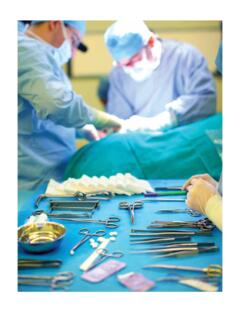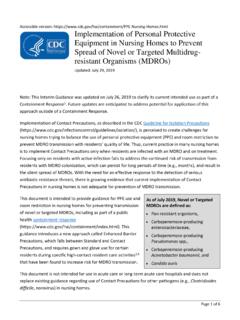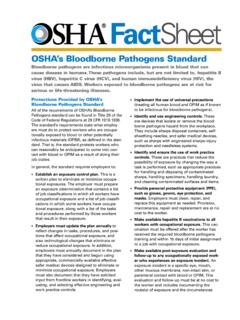Transcription of Infection prevention and control guidelines for the ...
1 Infection prevention and control guidelines for the management of COVID-19 in healthcare settings - Version 25 January 2022 Infection prevention and control guidelines for the management of COVID-19 in healthcare settings Version 25 January 2022 Infection prevention and control guidelines for the management of COVID-19 in healthcare settings - Version 25 January 2022 Page 2 Contents Purpose 4 Scope 4 Related documents 4 Background 4 Key principles 5 Infection prevention and control in healthcare settings 5 Hierarchy of controls 5 Standard precautions 5 Transmission-based precautions 6 General considerations 6 Non-COVID-19 patients 7 Confirmed COVID-19 cases, suspected COVID-19 cases and those with epidemiological evidence of COVID-19 7 Remaining patients 7 Personal protective equipment (PPE) 7 Room placement 8 Considerations on use of PPE 9 Safe use of PPE 9 Patient management considerations 10 Handling of paper health records 11 Care of the deceased 11 Staff considerations 11 Education 11 Testing 11 Vaccination 12 Physical distancing 12 Uniforms 12 Management of environment 12 Ventilation 12 cleaning 12 Outbreak management 14 Appendix 1: Patient placement (cohorting) advice 16 Suspect cases 16 Confirmed cases 16 Management of cohort areas 17 Appendix 2: PPE fitting and removal decision tree 19 Appendix 3.
2 Fever/testing clinics 20 Infection prevention and control principles 20 Appendix 4: Properties of PPE for use in healthcare 22 Infection prevention and control guidelines for the management of COVID-19 in healthcare settings - Version 25 January 2022 Page 3 Masks 22 Gowns 26 Eye protection 27 Gloves 28 Appendix 5: Quick reference information about P2/N95 respirators 29 Appendix 6: Management of deceased persons 34 Appendix 7: Factors increasing the risk of transmission 36 Appendix 8: Guide for PPE selection 38 Definition of terms 40 Review 41 Business area contact 41 Approval and implementation 41 Version control 42 References 44 Infection prevention and control guidelines for the management of COVID-19 in healthcare settings - Version 25 January 2022 Purpose This guideline provides Infection prevention and control recommendations for managing patients with suspected or confirmed COVID-19 in healthcare settings.
3 Scope This guideline provides information for all Queensland Health Hospital and Health Service (HHS) employees (permanent, temporary and casual) and all organisations and individuals acting as its agents (including visiting medical Officers and other partners, contractors, consultants and volunteers) and all Queensland licensed private health facilities. Related documents This guideline should be read in conjunction with the following: Communicable Diseases Network Australia: Coronavirus Disease 2019 (COVID-19) CDNA National guidelines for Public Health Units Infection control Expert Group (ICEG) Guidance on the use of personal protective equipment (PPE) for health care workers in the context of COVID-19 National COVID-19 Clinical Evidence Taskforce: Australian guidelines for SARS-CoV-2 Infection prevention and control of COVID-19 in healthcare workers Infection control Expert Group: Minimising the risk of infectious respiratory disease transmission in the context of COVID-19.
4 The hierarchy of controls Chief Health Officer Public Health Directions Queensland Health: Escalation of personal protective equipment usage in healthcare delivery, community health and care services, in-home care settings, and for healthcare delivery in correctional services Queensland Health: Escalation of personal protective equipment usage in residential aged care and disability accommodation services Queensland Health: Conserving personal protective equipment Australian Commission on Safety and Quality in Healthcare: Australian guidelines for the prevention and control of Infection in Healthcare Queensland Health: Fit testing of P2/N95 respirators in respiratory protection programs Queensland Health.
5 COVID-19 and managing employee health risks Background These Infection prevention and control recommendations combine recommendations found in the Communicable Diseases Network Australia (CDNA) Series of National guidelines (CDNA SoNG) Coronavirus 2019 (COVID-19), Infection control Expert Group (ICEG) Guidance on the use of personal protective equipment for Infection prevention and control guidelines for the management of COVID-19 in healthcare settings - Version 25 January 2022 Page 5 health care workers in the context of COVID-19, the World Health Organization (WHO) guideline, Infection prevention and control during health care when coronavirus disease (COVID-19) is suspected or confirmed, and other guidelines and papers (see references for full list).
6 Advice regarding the management of confirmed and suspected COVID-19 cases has evolved as further information associated with this disease has become known. As it has become available, this advice has been and will continue to be incorporated into this guideline. For further background information on SARS-CoV-2 and COVID-19 please refer to the CDNA SoNG, which contains sections on the infectious agent, mode of transmission, case definitions, infectious period, incubation period, testing, contact tracing and more. Key principles Cough and respiratory hygiene must always be maintained. Physical distancing is recommended by CDNA and should be maintained as much as practicable[1].
7 Stay at least metres[1] away from other people including: Patients, except when unavoidable, during physical examination and provision of care, and Members of the public, hospital visitors and other staff in wards, clinics and nonclinical areas, during meetings, in offices and shared workplaces and during tea breaks etc. General principles Check-in records for individual wards, departments and outpatient areas will assist in contact tracing activities if required. Assess any patients presenting with symptoms of respiratory illness for epidemiological evidenceb for COVID-19 within the last 14 days. Any person tested for COVID-19 should be isolated pending test results, excepting those undergoing routine surveillance COVID-19 screening for employment purposes.
8 Manage routine care of suspected or confirmed cases of COVID-19 using personal protective equipment (PPE) as per ICEG Guidance on the use of personal protective equipment for health care workers in the context of COVID-19 and current Queensland guidance. Infection prevention and control in healthcare settings Hierarchy of controls Guidance on consideration of the hierarchy of controls in the context of minimising the risk of COVID-19 transmission has been produced by the Infection control Expert Group. Standard precautions Standard precautions should be used when providing care to all patients[2] , whether or not they are suspected of having COVID-19 and are necessary to help prevent exposure/ Infection by asymptomatic or pre-symptomatic carriers of COVID-19.
9 Infection prevention and control guidelines for the management of COVID-19 in healthcare settings - Version 25 January 2022 Page 6 Standard precautions include hand hygiene, appropriate and correct use of PPE, respiratory hygiene and cough etiquette, reprocessing of reusable medical devices , cleaning of shared equipment, aseptic technique, sharps/waste handling and disposal, appropriate handling of linen and routine environmental cleaning [2] . Standard precautions apply to all settings where care is provided or where there is a risk of blood or body fluid exposure including acute and subacute care facilities, residential care facilities, home care settings, community settings and other settings such as mortuaries.
10 Healthcare workers should perform hand hygiene in accordance with the National Hand Hygiene Initiative program, 5 Moments for Hand Hygiene. All healthcare workers having direct contact with patients or a patient s environment should ensure they are Bare Below the Elbows. Transmission-based precautions The below criteria should be used to decide what level of PPE is required for an individual patient based on their risk for transmission of COVID-19. For advice on recommendations for escalation of PPE use in areas of moderate or high community transmission refer to Pandemic response guidance: Escalation of personal protective equipment usage in healthcare delivery, community health and care services, in-home care settings, and for healthcare delivery in correctional services, available at General considerations In accordance with the Infection control Expert Group Minimising the risk of infectious respiratory disease transmission in the context of COVID-19.













